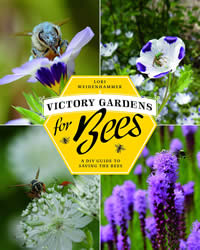 Anyone who regularly dresses up as a queen bee to educate children has to be passionate about her topic. Lori Weidenhammer, a performance artist based in Vancouver, British Columbia, is certainly that. That same energy is now available in her book, “Victory Gardens for Bees.” The sub-title well describes the book’s style: “A DIY Guide to Saving the Bees.” Weidenhammer wants you to be engaged!
Anyone who regularly dresses up as a queen bee to educate children has to be passionate about her topic. Lori Weidenhammer, a performance artist based in Vancouver, British Columbia, is certainly that. That same energy is now available in her book, “Victory Gardens for Bees.” The sub-title well describes the book’s style: “A DIY Guide to Saving the Bees.” Weidenhammer wants you to be engaged!
All this energy at first may distract you from the rich content. This is an excellent introduction and field guide to the many types of bees. Planting charts recommend plants for your gardens – starting with weeds! Each entry tells you which bees are attracted to the plant, and what it provides for them. Planting plans will suggest garden layouts. The photos, mostly by the author, are excellent at showing their small subjects in tremendous detail.
Sometimes, you may feel like a child at one of Queen Bee’s performances. Suppose you are accidently stung by a bee. “It hurts a lot and you will feel like unfriending bees. Don’t take it personally. Bad stings happen to good people. Once the pain goes away, you’ll be ready to forgive and refriend the bees.”
Excerpted from the Summer 2017 Arboretum Bulletin.
 Sue Goetz loves to pamper herself. Even more, she wants you to pamper you. How? There is no single answer to this, but in the “The Herb Lover’s Spa Book” she ardently helps you create your own special place – a personal spa to nurture yourself.
Sue Goetz loves to pamper herself. Even more, she wants you to pamper you. How? There is no single answer to this, but in the “The Herb Lover’s Spa Book” she ardently helps you create your own special place – a personal spa to nurture yourself.
This blissful goal isn’t reached without a lot of practical knowledge. The author’s experience as a garden designer helps you create a personal sanctuary in your own back yard. Similar principles are applicable to interior spaces, too.
Next, Goetz walks the reader through a concise list of herbal plants, each defined as “…cultivated for its usefulness in flavoring, perfume, or for cosmetic and medicinal uses.” Choosing, growing, harvesting, and preserving are all part of the lessons.
Finally, you create. Lotions and ointments to make your life a little easier, a little more enjoyable. The recipes are easy, difficult concepts are clearly explained, and there’s nothing else to do but try it. As you ease into your fragrance-enriched bathtub of steaming hot water, you’ll be glad you did.
Excerpted from the Summer 2017 Arboretum Bulletin.
 Karen Chapman and Christina Salwitz are crusaders for garden foliage. “Gardening with Foliage First” is their second book on this topic and greatly expands their 2013 book “Fine Foliage.” Their goal is to be your “personal design coaches,” and they tackle that project with great enthusiasm, starting with your choice of leaves. Flowers come later.
Karen Chapman and Christina Salwitz are crusaders for garden foliage. “Gardening with Foliage First” is their second book on this topic and greatly expands their 2013 book “Fine Foliage.” Their goal is to be your “personal design coaches,” and they tackle that project with great enthusiasm, starting with your choice of leaves. Flowers come later.
The authors have created a long list of vignettes of plant combinations. Some are simple, two or three plants, while others are very complex and may include ornaments. The setting can be in a large garden bed, or a simple pot. Flowers are allowed, but they must compliment the foliage and be chosen for embellishment. They are not the stars of the show.
The plans all have crazy names. For example, “The Ticklish Porcupine” includes a prickly pear cactus (Opuntia engelmannii) surrounded by Mexican feather grass (Nassella tenuissima). Why these designs work is carefully explained, along with general culture tips. Best is how the design will change with time. Attention is also drawn to potential problems, such as the invasiveness of the above-mentioned feather grass.
Excerpted from the Summer 2017 Arboretum Bulletin.
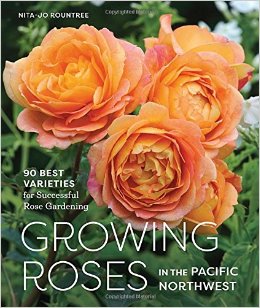 Nita-Jo Rountree move to the Bellevue, Washington 15 years ago after many years as a Master Gardener and the owner of a landscape design and installation company in Atlanta. She quickly learned to separate reality from the myths of our climate and she has used that knowledge to specialize in roses, one her favorite plants – perhaps her very favorite plant (she’s a bit coy on this subject; I know she loves hydrangeas, too).
Nita-Jo Rountree move to the Bellevue, Washington 15 years ago after many years as a Master Gardener and the owner of a landscape design and installation company in Atlanta. She quickly learned to separate reality from the myths of our climate and she has used that knowledge to specialize in roses, one her favorite plants – perhaps her very favorite plant (she’s a bit coy on this subject; I know she loves hydrangeas, too).
She has chosen an impressive list of roses in all classes, all bred for health, or that have proved their durability in our region without a lot of fussing. Many of them are recent introductions that reflect the work of hybridizers for the home gardener, but she doesn’t ignore species or historical roses.
I have a passing knowledge of rose varieties, mostly from a brief period of heavy immersion in gardening with roses many years ago. At the same time, I learned a lot about the frequent spraying and other chemical rites of rose growing, as this was the expectation in almost every rose books of the time. Today, I only know a handful of Rountree’s recommendations. There is a good reason for this as her newer, recommended varieties don’t need the level of coddling I learned, thus avoiding the potential damage to the garden environment, the wildlife of the garden large and small, or to the gardener.
Rountree is emphatic in her most important advice. “Remember: The most important key to successful rose growing is choosing the right rose for the right place. Many books and articles about roses give generic advice for growing roses in a wide range of climates. They are of little specific help for growing roses in the Pacific Northwest.”
Excerpted from the Summer 2017 Arboretum Bulletin.
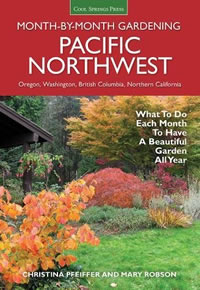 Gardening books that use a calendar format are especially valuable to newer gardeners, and having one that’s tailored to our region is even better. Best of all is having an author who worked in the Washington Park Arboretum for many years! Christina Pfeiffer brings her considerable experience to “Month-By-Month Gardening Pacific Northwest” and has consultation help from Mary Robson, a retired Horticulture Extension agent for Washington State University.
Gardening books that use a calendar format are especially valuable to newer gardeners, and having one that’s tailored to our region is even better. Best of all is having an author who worked in the Washington Park Arboretum for many years! Christina Pfeiffer brings her considerable experience to “Month-By-Month Gardening Pacific Northwest” and has consultation help from Mary Robson, a retired Horticulture Extension agent for Washington State University.
The same pair collaborated on a 2005 book, with Robson taking the lead on that publication. This new book begins with a short but very meaty introduction chapter covering the basics. The monthly chapters that follow build on the introduction with topics cleverly positioned when you’ll most likely want the advice. For example, in June we learned how to turn an area of your lawn into a garden bed, perfect timing so it will be ready for fall planting.
I appreciate that each month begins with a section on planning. What do you want from your garden? What is working well? What needs changing? Only after you’ve asked and answered these questions, do you start doing. These activities sections include planting and all aspects of caring for common garden plants ranging from annuals to trees. Lawns and houseplants are considered, too.
You are also encouraged to get out to nurseries and plant festivals, and to see our native plants where and when they are at their peak. Enjoying your own and other gardens is important, too. During July, “pause to revel in the beauty and bounty the garden has to offer. This is a time for picnics in the shade and leisurely strolls at local parks and gardens.”
Excerpted from the Summer 2017 Arboretum Bulletin.
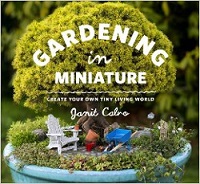
As a boy, I did not embrace the hobby of making models. Yes, I had a train set, but no desire to create a world of villages, forests, and the like to surround the tracks. Instead, I wanted to be outside in the garden and working with full-sized plants.
This makes me feel a bit inadequate to review “Gardening in Miniature” by Seattleite Janit Calvo. However it turns out that at its heart, this is a gardening book, with sound design advice and cultural tips, just all at 1:12 (one inch = one foot) scale, or even smaller.
“Using the basic garden tenets of anchor point, balance, layers, texture, color, and focal point, you can plan your miniature garden with confidence,” the author states encouragingly. Step-by-step, fully planned projects provide lots of guidance for the beginner. I worried that plants would not stay to scale, and indeed they might not, but it’s easy to swap plants in and out.
I learned from this that while there is some overlap in principles and techniques between miniature gardening and bonsai, they are largely distinct pursuits. However, they can be combined by making a bonsai the centerpiece of your miniature garden. Will I take up miniature gardening? Probably not. But my eyes have been opened to a whole new—and quite small—world.
Excerpted from the Spring 2014 Arboretum Bulletin.
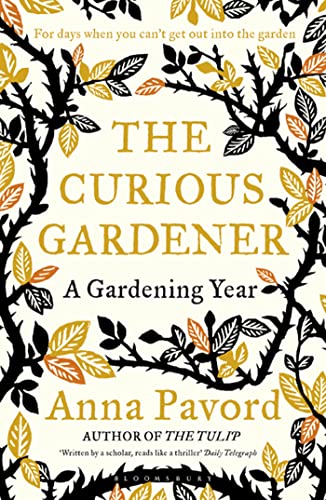 Much fun is found in The Curious Gardener, published by Anna Pavord in 2010. This collection of writings from the British newspaper The Independent includes a serviceable gardening calendar for our region, but I’d especially check it out for the pure pleasure of essays written by a kindred, but at times contrary, gardening soul.
Much fun is found in The Curious Gardener, published by Anna Pavord in 2010. This collection of writings from the British newspaper The Independent includes a serviceable gardening calendar for our region, but I’d especially check it out for the pure pleasure of essays written by a kindred, but at times contrary, gardening soul.
She begins with a tongue-in-cheek, astrological calendar of gardening signs (as a Pisces, it is good to know my intuition will help me “…recognize that a plant is in difficulty long before it is past saving”). Later she judges potential lovers by the choice of flowers they give on Valentine’s Day.
This same article brings out her political and environmental side, as she laments the ecological disaster caused by the huge business of producing cut flower roses in South America during the northern hemisphere winter.
An added bonus are the wood engravings by Howard Phipps, carved on the end grain of a block of very hard boxwood, using a technique that reached its pinnacle in the mid-19th century. It’s appropriate that the artist used a hand press from 1862 for the final images.
Published in Garden Notes: Northwest Horticultural Society, Summer 2017
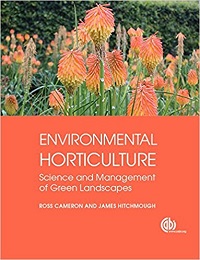
The subject of Environmental Horticulture, a new book in the Miller Library by Ross Cameron and James Hitchmough, is best described by the book’s subtitle: “Science and Management of Green Landscapes.” The intended audience is broad, but I would recommend it for professionals managing large landscapes used for almost any purpose, and for students researching landscape management principles.
This book covers many topics, beginning with the value of green spaces for human well-being and biodiversity. Many types of plantings are considered, ranging from trees and shrubs to bedding plants, and including formal settings and semi-natural grasslands. Even plantings as diverse as lawns or sports turf and green roofs or rain gardens are studied with the same depth of research as other types.
The authors define Environmental Horticulture as “…the subset of horticulture that is concerned with the use and management of plants in public and semi-public environments.” They discuss how this term is nearly the equivalent of “urban horticulture” or “landscape horticulture” with the difference uses reflecting national preferences. “Urban horticulture,” for example, hasn’t caught on as a descriptor in Great Britain.
The authors are on the faculty of the Department of Landscape at the University of Sheffield in England. Although some of the terminology is distinctly British, much of the discussion is based on North American research. One of the most valuable assets of this book are the references, which include many American sources.
Published in the May 2017 Leaflet for Scholars Volume 4, Issue 5.
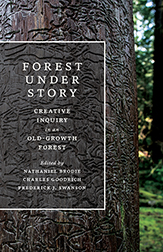
The H. J. Andrews Experimental Forest east of Eugene was established in 1948. At nearly 16,000 acres, it covers the entire Lookout Creek watershed on the west side of the Cascades. The Forest is used to study ecosystems, wildlife, logging practices, and many other natural and human processes in both old-growth and managed forests.
Started in 2003, the Long-Term Ecological Reflections program through Oregon State University sponsors “writers-in-residence” to spend one to two weeks in the Andrews Forest. Collectively, they have “…come to know the forest via the paths laid down in stories, stories told in anecdotes, photographs, essays, and poems, or in hypotheses, data, and graphs.”
The founders of this program are ambitious; they expect it to continue for 200 years. Fortunately, as readers, we don’t have to wait so long to read the results. Some of the early creativity is now captured in the book “Forest Under Story.”
This is a collection of poems, essays, and even field notes. Interspersed sections titled “Ground Work” provide the scientific basis that supports the more artistic writing. The black and white photography of Bob Keefer offers further context. This is a book to savor slowly, with lessons that are applicable to all coastal forests.
Excerpted from the Spring 2017 Arboretum Bulletin.
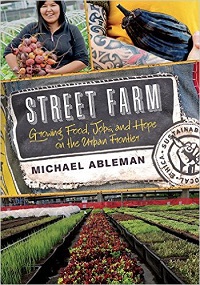
Street Farm is not a gardening book, but I’m reviewing it because it has a powerful message of the benefits of gardening, or – more accurately – urban farming, especially for those who do not have much else to bring hope and well-being to their lives. Author Michael Ableman is the co-founder of Sole Food Street Farms, a charitable organization that includes four farms on abandoned lots in downtown Vancouver, B. C. This book is the story of that organization and the people it has hired to become the urban farmers.
The neighborhoods around these farms are not tourist attractions. The author points out that “…while Vancouver’s prosperity is celebrated, its concentration of poverty and raw desperation endures in the midst of the polished and the preened.”
There are losses on these farms, both of the produce and of the humans who tend the crops, but overall this is a book of hope. Ableman is very clear that this endeavor is not a panacea for the challenges of poverty, mental health diseases, or addictions. He also recognizes his is a position of privilege by always having “…had a place to live and food to eat, and the color of my skin is not black or brown.”
Besides the human stories, all gardeners will relate to the challenges of growing plants in less than ideal circumstances, including outsmarting pests, in this case a sophisticated rat population that only chooses the best vegetables. No less interesting is the harvesting and marketing of crops to the more than 30 restaurants and five farmers markets that Sole Food supplies, plus its CSA (Community Supported Agriculture) shares and donations of over $20,000/year to community kitchens.
Excerpted from the Spring 2017 Arboretum Bulletin.
 Anyone who regularly dresses up as a queen bee to educate children has to be passionate about her topic. Lori Weidenhammer, a performance artist based in Vancouver, British Columbia, is certainly that. That same energy is now available in her book, “Victory Gardens for Bees.” The sub-title well describes the book’s style: “A DIY Guide to Saving the Bees.” Weidenhammer wants you to be engaged!
Anyone who regularly dresses up as a queen bee to educate children has to be passionate about her topic. Lori Weidenhammer, a performance artist based in Vancouver, British Columbia, is certainly that. That same energy is now available in her book, “Victory Gardens for Bees.” The sub-title well describes the book’s style: “A DIY Guide to Saving the Bees.” Weidenhammer wants you to be engaged! Sue Goetz loves to pamper herself. Even more, she wants you to pamper you. How? There is no single answer to this, but in the “The Herb Lover’s Spa Book” she ardently helps you create your own special place – a personal spa to nurture yourself.
Sue Goetz loves to pamper herself. Even more, she wants you to pamper you. How? There is no single answer to this, but in the “The Herb Lover’s Spa Book” she ardently helps you create your own special place – a personal spa to nurture yourself. Karen Chapman and Christina Salwitz are crusaders for garden foliage. “Gardening with Foliage First” is their second book on this topic and greatly expands their 2013 book “Fine Foliage.” Their goal is to be your “personal design coaches,” and they tackle that project with great enthusiasm, starting with your choice of leaves. Flowers come later.
Karen Chapman and Christina Salwitz are crusaders for garden foliage. “Gardening with Foliage First” is their second book on this topic and greatly expands their 2013 book “Fine Foliage.” Their goal is to be your “personal design coaches,” and they tackle that project with great enthusiasm, starting with your choice of leaves. Flowers come later. Nita-Jo Rountree move to the Bellevue, Washington 15 years ago after many years as a Master Gardener and the owner of a landscape design and installation company in Atlanta. She quickly learned to separate reality from the myths of our climate and she has used that knowledge to specialize in roses, one her favorite plants – perhaps her very favorite plant (she’s a bit coy on this subject; I know she loves hydrangeas, too).
Nita-Jo Rountree move to the Bellevue, Washington 15 years ago after many years as a Master Gardener and the owner of a landscape design and installation company in Atlanta. She quickly learned to separate reality from the myths of our climate and she has used that knowledge to specialize in roses, one her favorite plants – perhaps her very favorite plant (she’s a bit coy on this subject; I know she loves hydrangeas, too). Gardening books that use a calendar format are especially valuable to newer gardeners, and having one that’s tailored to our region is even better. Best of all is having an author who worked in the Washington Park Arboretum for many years! Christina Pfeiffer brings her considerable experience to “Month-By-Month Gardening Pacific Northwest” and has consultation help from Mary Robson, a retired Horticulture Extension agent for Washington State University.
Gardening books that use a calendar format are especially valuable to newer gardeners, and having one that’s tailored to our region is even better. Best of all is having an author who worked in the Washington Park Arboretum for many years! Christina Pfeiffer brings her considerable experience to “Month-By-Month Gardening Pacific Northwest” and has consultation help from Mary Robson, a retired Horticulture Extension agent for Washington State University.
 Much fun is found in The Curious Gardener, published by Anna Pavord in 2010. This collection of writings from the British newspaper The Independent includes a serviceable gardening calendar for our region, but I’d especially check it out for the pure pleasure of essays written by a kindred, but at times contrary, gardening soul.
Much fun is found in The Curious Gardener, published by Anna Pavord in 2010. This collection of writings from the British newspaper The Independent includes a serviceable gardening calendar for our region, but I’d especially check it out for the pure pleasure of essays written by a kindred, but at times contrary, gardening soul.

